American Black Bear Tracks and Sign:
A Field Guide Account
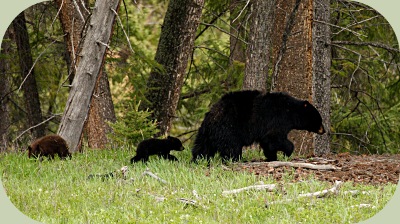
Ursus americanus
The American black bear is the most common and most adaptable bear species in North America. It is found in a variety of habitats including arctic tundra, hardwood forests, riparian areas, swamps, coniferous forests and forested mountain regions. They are absent in the central plains and open desert regions of the continent. Black bears share some of their range with grizzly bears, and can be distinguished from them by their shorter claws, lack of muscular hump between the shoulders and straight face profile (versus the grizzlies more dish-shaped face profile). Though called "black" bears, they come in a variety of colors and shades including black, brown, cinnamon, grayish, blonde and white. As you can see in the photo above, cubs born of the same litter can be two or more different colors. Black bears average between 90 and 400 pounds in weight, with males generally being the larger and heavier sex. The diet of the American black bear is varied and includes: fruit, berries, shoots, bulbs, tubers, buds, catkins, insects, young ungulates, and fish.
American Black Bear Tracks
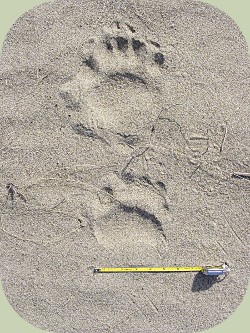
Tracks: The tracks of the American black bear are flat-footed, large and rather human like in appearance. Unlike human feet, however, bears have their largest toe to the outside of their feet, their feet are more robust and rounder, and they have sharp claws. Bears show 5 toes on both front and hind tracks. The claws on both front and hind often show up in the tracks. The negative space between the toes is filled with fur.
The front feet are blocky, with a somewhat rectangular metacarpal pad. Their small, rounded heel pad appears sometimes in tracks as a circle separate from and below the metacarpal pad. The claws on the front feet are longer and show up farther from the toes in the tracks.
Front: generally between 3.75” to about 8” long by 3.25” to 6” wide.
The rear tracks are also blocky, with the metacarpal having a fused heel and palm portion of the foot. When the whole foot is visible in the track, the rear foot will appear longer and the heel portion tapers to a blunted point. Sometimes the back of the rear foot does not register in the track. The claws on the rear feet tend to be shorter. A "v" of fur cuts into the rear metacarpal pad and may show up in the track.
Rear: generally between 5.25” to 8.8” long by 3.5” to 6” wide.
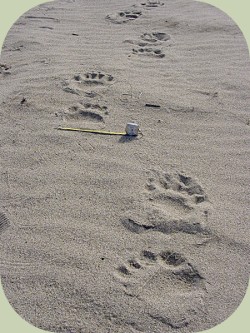
Gaits: The American black bear travels over the landscape mainly by walking, but it can also trot, lope and gallop. These bears often travel in an overstep walk, in which the rear track lands ahead of the front track. The overstep walk is generally between 19” to 28” stride length and 8” to 14” trail width. While in a lope, the stride length is generally 25” to 30” and group length (length of the entire set of 4 tracks together) is 38” to up to 50” long.
American Black Bear Sign
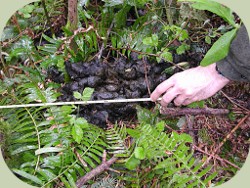
Scat: Due to the black bears varied diet, the scat comes in different forms. Most commonly, the scat is tubular and segmented and often in piles. If the diet is full of moisture, it may be more amorphous. Often the seeds, fruit skin, berries or fur is visible in the scat. When firmer, the scat generally measures about 1.25” to 2.5” in diameter and between 5” to 12” long.
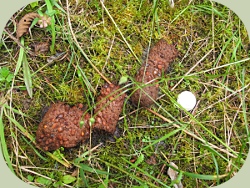
Here is another scat made up of fruit and seeds.
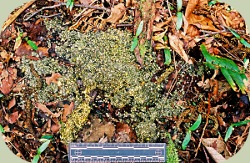
This scat was full of bird seed, likely from local bird feeders in the suburban area near to where this scat was discovered.
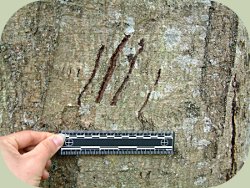
Other sign: American black bear also leave behind other sign. One of the most common is claw marks on trees. Bears will climb certain trees such as aspen in the springtime to reach their buds.
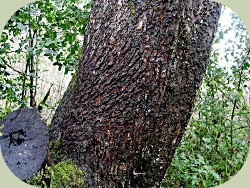
Bears will also climb fruit trees later in the year. They are fond of many types, including apples. The photo on the right demonstrates what many years of bear use can look like on an old apple tree! Notice the layers-upon-layers of claw marks cutting grooves in the trees bark.
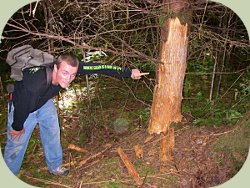
Also, in the springtime some bears will feed on the cambium of young trees. They pull off the bark and rake the juicy cambium with their lower incisor teeth.
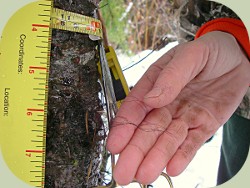
Trees are often used for scent marking when communicating with other bears. The trees they choose tend to be along regular travel routes, and often near food resources or bedding areas. Bears will rub, scratch and often stand up and bite trees to communicate their neighbors about their health, mating status, sex, and many other things. Notice the hair contrasting against the hand and stuck to this rubbing tree in the photo on the right.
Be More Prepared For Your Next Outdoor Adventure!

Don't leave without knowing these six essential survival skills. Our free survival mini guide reveals the strategies of:
- Shelter & fire to prevent the number one cause of death
- Obtaining clean water to avoid life-threatening dehydration
- Common wild survival foods and other critical skills!

Similar Tracks: Grizzly bear tracks are similar, but tend to be larger measuring 7 – 13” long by 5-8.75” wide for fronts, and 8.25-14” long by 4.75 – 8.5” wide for rears. The claws on the front feet of grizzly bears are generally longer than those of black bears. Polar bears are limited to the region around the far Arctic coastal areas that are not inhabited by black bears. On a much smaller scale skunk tracks can appear similar and you can see in more detail here: Skunk Tracks Article.
References: Elbroch 2003, MacDonald 2001, Murie 1954.
Additional Resources:
Black Bear Tracks - Bear Tracker's Pages
Related Courses:
By the way, when you're out tracking or looking for wild animals, it's important to know how to stay safe in the outdoors, especially if you were to get lost. Right now you can get a free copy of our mini survival guide here, where you'll discover six key strategies for outdoor emergencies, plus often-overlooked survival tips.

About the Author: Filip Tkaczyk is a periodic guest teacher at Alderleaf. He also wrote the field guide Tracks & Sign of Reptiles & Amphibians. Learn more about Filip Tkaczyk.
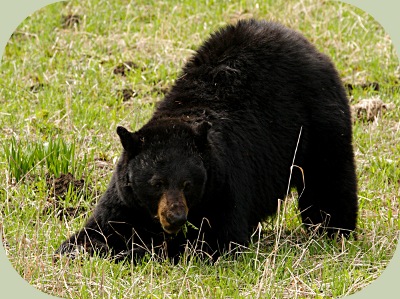
Return from American Black Bear Tracks to Wildlife Tracking Articles
Is The Essential Wilderness Survival Skills Course Right for You? Take the "Online Survival Training Readiness" Quiz
See for yourself if this eye-opening course is a good fit for you. It takes just a few minutes! Get your Survival Training Readiness Score Now!

Grow Your Outdoor Skills! Get monthly updates on new wilderness skills, upcoming courses, and special opportunities. Join the free Alderleaf eNews and as a welcome gift you'll get a copy of our Mini Survival Guide.

 The Six Keys to Survival: Get a free copy of our survival mini-guide and monthly tips!
The Six Keys to Survival: Get a free copy of our survival mini-guide and monthly tips!
Learn more